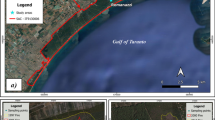Abstract
The results of studying the dynamics of forest litter properties in the loci of a Siberian moth (Dendrolimus sibiricus) mass outbreak are considered. As a fir forest defoliated by this pest burns, the reserves and fractional composition of the forest litter, its actual acidity, and its chemical composition drastically change. Upon the burning out of such forests, the litter complex of invertebrates is fully destroyed and begins restoring only two years after the fire.
Similar content being viewed by others
References
E. V. Arinushkina, Handbook on the Chemical Analysis of Soils (Moscow) [in Russian].
Yu. N. Baranchikov and R. P. Kharitonchenko, “diurnal Dynamics of Insect Excrement Intake to Litter in the Focus of Reproduction of Siberian Moth,” in Role of Litter in Forest Biogeocenoses (Nauka, Moscow, 1983), pp. 18–19 [in Russian].
L. G. Bogatyrev, T. G. Shchenina, and M. S. Komarova, “Characterization of Forest Litters during the Regeneration of Cutover Stands in the Southern-Taiga Subzone,” Pochvovedenie, No. 7, 106–113 (1989).
V. N. Gorbachev, V. K. Dmitrienko, E. P. Popova, and N. D. Sorokin, Soil-Ecological Studies in Forest Biogeocenoses (Nauka, Novosibirsk, 1982) [in Russian].
V. Dunger, “Calculation of Microarthropodes (Microfauna),” in Quantitative Methods in Soil Zoology (Nauka, Moscow, 1987), pp. 26–51 [in Russian].
S. V. Zonn, Effect of Forest on Soil (Akad. Nauk SSSR, Moscow, 1954) [in Russian].
S. V. Zonn, “Soils as a Component of Forest Biogeocenosis,” in Principles of Forest Biogeocenology (Nauka, Moscow, 1964) [in Russian].
L. O. Karpachevskii, Forest and Forest Soils (Lesnaya Promyshlennost’, Moscow) [in Russian].
L. O. Karpachevskii, “Litter as a Particular Biogeohorizon of Forest Biogeocenosis,” in Role of Litter in a Forest Biogeocenosis (Nauka, Moscow, 1983) [in Russian].
Controlled Burnings on Cutover Stands in Mountain Forests (Ross. Akad. Nauk, Novosibirsk, 2001) [in Russian].
Yu. N. Krasnoshchekov and Z. V. Vishnyakova, “Changes in Properties of Soils in Foci of Siberian Moth (Dendrolimus sibiricus) Outbreaks,” Pochvovedenie, No. 12, 1453–1462 (2003) [Eur. Soil Sci. 36 (12), 1298–1306 (2003)].
Yu. N. Krasnoshchekov, E. N. Valendik, I. N. Bezkorovainaya, et al., “Soil-Ecological Changes under the Controlled Burning of Silkmoth-Damaged Forests in the Southern Taiga of the Yenisei Region,” Izv. Akad. Nauk, Ser. Biol., No. 3, 375–384 (2004).
D. A. Krivolutskii, Soil Fauna in Ecological Control (Nauka, Moscow, 1994) [in Russian].
D. A. Krivolutskii, Moss Mites: Morphology, Development, Phylogeny, and Characterization of the Model Species Nothrus ralustris (Nauka, Moscow, 1995) [in Russian].
V. D. Perevoznikova and Yu. N. Baranchikov, “Structure of Overground Phytomass Reserves in the Fir Forests of the Lower Angara Region Recently Damaged by Silkmoth,” in Entomological Studies in Siberia (Krasnoyarsk, 2002), vol. 2, pp. 166–180 [in Russian].
E. P. Popova, “Composition and Chemical Properties of Litters on Different-Aged Fire Sites in Pine Forests of the Angara Region,” in Agrophysical Studies of Soils in the Middle Siberia (Krasnoyarsk, 1975) [in Russian].
E. P. Popova, “Pedogenesis in Forest Biogeocenoses of the Angara Region Depending on the Remoteness of Fires,” in Genesis and Geography of Soils (Nauka, Moscow, 1980) [in Russian].
L. E. Rodin, N. P. Remezov, and N. I. Bazilevich, Methodological Recommendations for the Study of Dynamics and Biological Cycle in Phytocenoses (Nauka, Leningrad, 1968) [in Russian].
I. N. Skrynnikova, “Methods of Studying the Chemical Composition of Soil Liquid Phase,” in Stationary Methods of Soil Studies (Nauka, Moscow, 1977), pp. 3–40 [in Russian].
A. I. Utkin, “Effect of Fire on the Nature and Development of Larch Forests in the Central Yakutia,” Lesn. Khoz., No. 1, 46–50 (1965).
V. V. Furyaev, Silkmoth-Damaged Taiga Forests and Their Burning (Nauka, Moscow, 1966) [in Russian].
Author information
Authors and Affiliations
Additional information
Original Russian Text © Yu.N. Krasnoshchekov, I.N. Bezkorovainaya, V.V. Kuz’michenko, 2007, published in Pochvovedenie, 2007, No. 2, pp. 170–178.
Rights and permissions
About this article
Cite this article
Krasnoshchekov, Y.N., Bezkorovainaya, I.N. & Kuz’michenko, V.V. Transformation of forest litter properties under controlled burning of fir forests defoliated by Siberian moths in the Lower Angara River basin. Eurasian Soil Sc. 40, 149–157 (2007). https://doi.org/10.1134/S1064229307020044
Received:
Issue Date:
DOI: https://doi.org/10.1134/S1064229307020044




